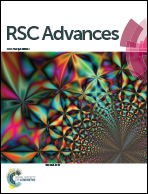Content-dependent biomineralization activity and mechanical properties based on polydimethylsiloxane–bioactive glass–poly(caprolactone) hybrids monoliths for bone tissue regeneration†
Abstract
In this study, polydimethylsiloxane–bioactive glass–poly(caprolactone) (PDMS–BG–PCL) hybrid monoliths with various PDMS–BG contents were successfully fabricated via a typical sol–gel route. As a reinforcement, the PDMS–BG was used to improve the biomineralization activity, mechanical properties and osteoblasts biocompatibility of PCL polymer. The incorporation of PCL significantly decreased the formation time and increased the toughness of crack-free PDMS–BG–PCL hybrid monoliths. The mechanical properties of PDMS–BG–PCL hybrid monoliths were significantly affected by the content of PDMS–BG and PDMS–BG–PCL (30 wt%) showed a much higher elastic modulus (328.87 ± 18.82 MPa). The hydrophilicity of PDMS–BG–PCL hybrids was also increased as the PDMS–BG increased. Additionally, the biomineralization activity of PDMS–BG–PCL hybrid monoliths could be tailored by the PDMS–BG content. All PDMS–BG–PCL hybrids could induce fast deposition of a crystalline apatite layer on their surface in SBF for 7 days. The in vitro cellular studies also showed that PDMS–BG–PCL hybrids can enhance osteoblasts attachment and cell viability compared with PCL. The crack-free monolith structure, biomimetic hybrid composition and high apatite-forming bioactivity make PDMS–BG–PCL hybrid a promising candidate as scaffolds and implants for drug delivery and bone regeneration applications.


 Please wait while we load your content...
Please wait while we load your content...